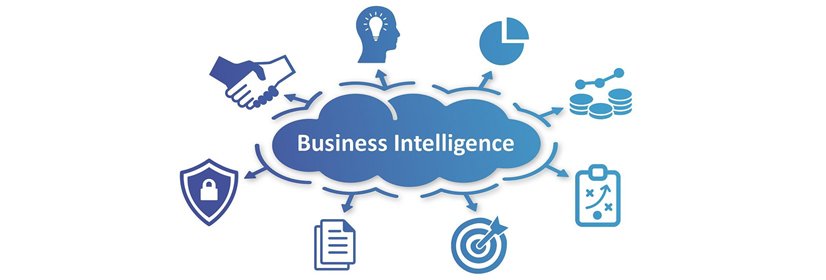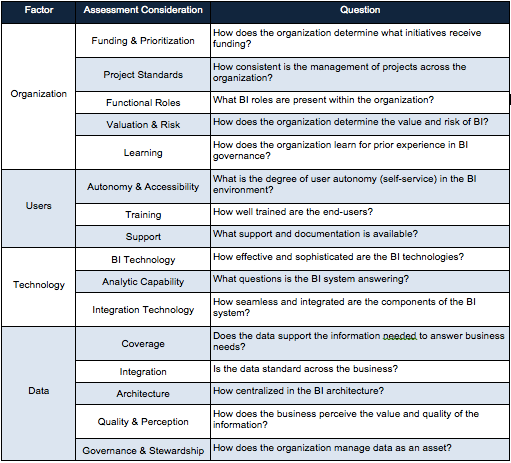We’re ready to get started, are you?
Get in touch and we can connect you with the right people.

In the last five years, CIOs have consistently ranked Business Intelligence (BI) as a top strategic spending priority. Yet organizations are still struggling with the challenge of realizing the full potential of the vast and growing analytic insight contained in their data. In addition, spending prioritization for cloud, virtualization and IT management have lessened the available budget for strategic BI initiatives. This change in prioritization is a reaction to financial reality as organizations seek to cut costs. However, BI remains a strategic priority, and organizations need to manage the costs and benefits associated with BI. In order to maintain a competitive advantage in the marketplace while addressing financial constraints, organizations must continuously examine their BI environments to identify improvement areas and capitalize on available opportunities. Assessing an organization’s BI maturity level based on a formal evaluation process is the critical starting point for any effort to enhance BI capabilities. “If you don’t know where you are, a map won’t help”, a derivation of a Chinese proverb by Watts S. Humphrey, considered the Father of Software Quality, ingeniously captures the key notion that improvement processes and methods, regardless of sophistication, are useless in the absence of a thorough understanding of present state.
This white paper discusses a structured assessment method for BI systems based on a balanced combination of objective and subjective evaluation criteria. These criteria integrate the broad variety of factors influencing the ultimate business value of BI investments, encompassing human, organizational, technological, and business process variables. The methodology’s design provides a solid and consistent framework to perform a comprehensive maturity evaluation a BI environment.
In the evaluation of virtually all information systems, a fundamental challenge is recognizing that technology does not solve all of an organization’s pain points. Business value in BI systems arises from the concerted interplay of people, technology, data, and business processes. Most efforts by organizations to increase the effectiveness of BI systems focus on the tactical data and technology issues. Yet, people and processes, regardless of technology, have a critical impact upon the efficiency and success of a BI system. The following issues exemplify this category:
Ignoring these key factors leads to an incomplete and skewed understanding of any BI system, which in turn severely diminishes the strategic value of BI investments. This incomplete vision often persists chronically despite the use of state-of-the-art technology, skilled analysts, and vast amounts of data.
Another pervasive challenge is misplaced focus on technical operation and architecture of BI systems instead on their capability to deliver business insight to decision makers. Very commonly, technology itself drives the evolution of BI systems. Some symptoms of this phenomenon are:
Regardless of technology and architecture choices, the purpose of a BI system is to provide critical business information that is accurate, timely, and relevant to support informed decision-making and optimal operation of the business. As a BI system matures, its ability to deliver value increases through a progressive set of evolutionary stages, summarized as follows:
The business can use the BI maturity assessment to plan a direction for the system to align its evolution with the needs and strategy goals of the company.
Overcoming BI maturity deficiencies is possible by applying a structured assessment methodology that clearly identifies the characteristics of a highly effective BI system and a concrete process to achieve them. The conceptual outline of this methodology is as follows:
The subjective assessment of the reviewer is an inevitable bias, but the use of a structured assessment methodology, which integrates all relevant aspects of the environment, can minimize the reviewer bias. The HARKEN DATA BI Maturity Assessment methodology evaluates a BI system holistically based on this principle.

The structured assessment considers factors that affect the BI system:
The methodology assists in the unbiased review of the following:

The HARKEN DATA BI Maturity assessment structures the evaluation across the four areas with 20 sub-categories to provide a holistic assessment of a BI system.
The main purposes of the recommendations from a BI Maturity Assessment are to:
Current trends in growing market pressures and uncertain economic conditions require that leading businesses take control of their strategic information assets. A BI maturity assessment provides a robust framework to rationalize and identify optimal capital investments with measurable positive impact in an organization’s business intelligence capabilities.
About HARKEN DATA:
HARKEN DATA is a strategy and technology consultancy focused exclusively on the delivery of Data Intelligence Solutions. HARKEN DATA consultants have proven experience and the technical and industry expertise that can help your organization achieve new levels of operational excellence. Learn more about HARKEN DATA at www.harkendata.com.
Get in touch and we can connect you with the right people.